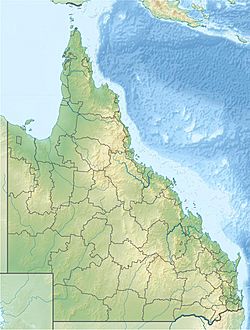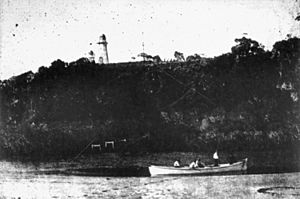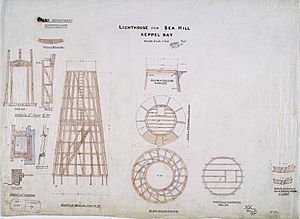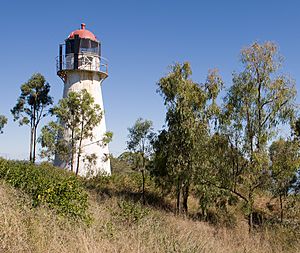Sea Hill Light facts for kids
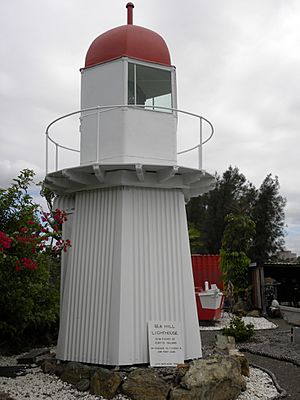 |
|
| The first little Sea Hill Lighthouse, on display at the Gladstone Maritime Museum | |
|
|
|
| Location | Curtis Island Queensland Australia |
|---|---|
| Coordinates | 23°29′27.5″S 150°58′49.4″E / 23.490972°S 150.980389°E |
| Year first constructed | 1873 or 1876 (first) 1895 (second) |
| Deactivated | 2006? |
| Construction | hardwood frame covered by corrugated galvanised iron tower |
| Tower shape | conical tower with balcony and lantern |
| Markings / pattern | white tower, red lantern dome |
| Height | 13 metres (43 ft) |
| Focal height | 33 metres (108 ft) |
| Characteristic | Fl (2) W 6s. |
| Admiralty number | K3000 |
| NGA number | 111-10320 |
| ARLHS number | AUS-196 |
The Sea Hill Lighthouse is a famous lighthouse located on the northwest tip of Curtis Island in Queensland, Australia. It's also known as Sea Hill Point Light or Little Sea Hill Light. Its main job was to guide ships safely into Keppel Bay, helping them find their way to places like the Fitzroy River and Port Alma.
Interestingly, there have been two lighthouses at Sea Hill. The first one was built around 1873 or 1876. It was later moved and you can now see it at the Gladstone Maritime Museum! A second lighthouse was built in 1895, but its condition today isn't fully known.
The Story of Sea Hill Lighthouse
People realized a lighthouse was needed here way back in 1864. This would help ships navigate the waters safely.
The First Lighthouse
The very first lighthouse at Sea Hill was built in 1873 or 1876. It was special because it was the first lighthouse in Queensland made with a hardwood frame covered in corrugated iron. This design was so good that seven more lighthouses in Queensland were built using the same style! These included the Grassy Hill Light and the Goods Island Light.
When the second lighthouse was built in 1895, the first one became a "front light." This means it worked together with the new lighthouse to create a guiding line for ships. In the 1920s, this first lighthouse was moved about 6 kilometres (3.7 mi) northeast to Station Point. It stayed there until the 1960s when it was no longer needed. After that, it was sold to a private owner. Today, you can visit it at the Gladstone Maritime Museum.
This lighthouse is quite short, standing only 20 feet (6.1 m) tall. Unlike most other lighthouses of its type in Queensland, it has a six-sided shape instead of being round. It has a balcony and a lantern on top. Like many Queensland lighthouses, it is painted white with a red dome.
The Second Lighthouse
The second Sea Hill Lighthouse was built in 1895. For a while, it acted as the "rear light" in the guiding system. This lighthouse is about 12-metre-high (39 ft). It's also made with a timber frame and covered in corrugated iron, with a lantern and a balcony.
Originally, the light used a special lens and burned kerosene. In 1930, it was updated to use acetylene gas with a "sun valve." This valve would turn the light on automatically when it got dark and off when the sun came up. This system worked for many years, at least until 1975. By 1977, the old lens was replaced with a modern, solar-powered electric beacon.
A special station for ship pilots was set up nearby in 1919, but it closed in 1963.
The current condition of the second lighthouse is a bit of a mystery. Some reports say it stopped working in 2006. While there were rumors it was taken down in 2009, other reports from 2014 said it was still standing. The 2018 List of Lights still shows a light at this spot. It's listed as being 39-foot-high (12 m) with its light shining from 109 feet (33 m) above the water. It flashes white twice every six seconds.


